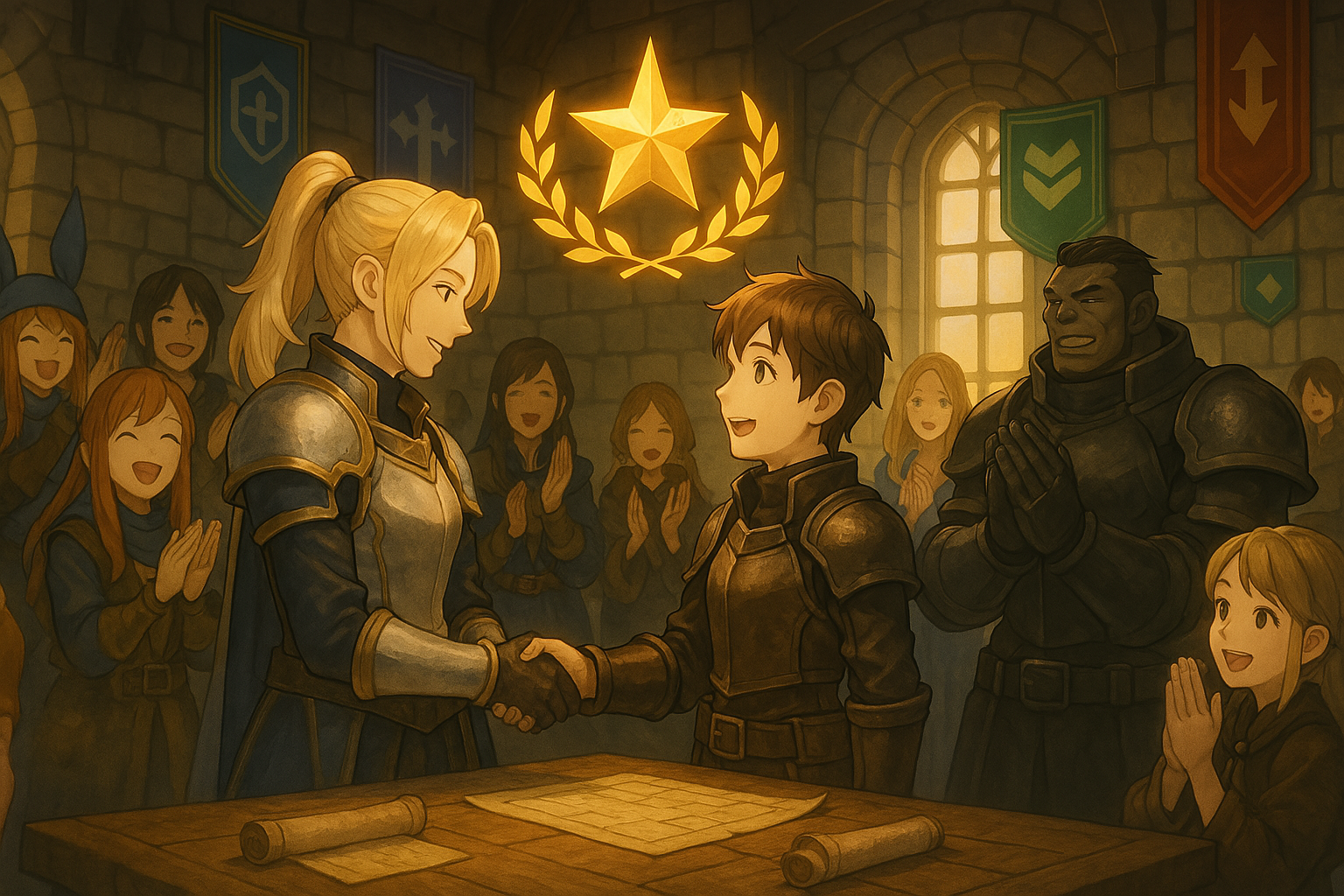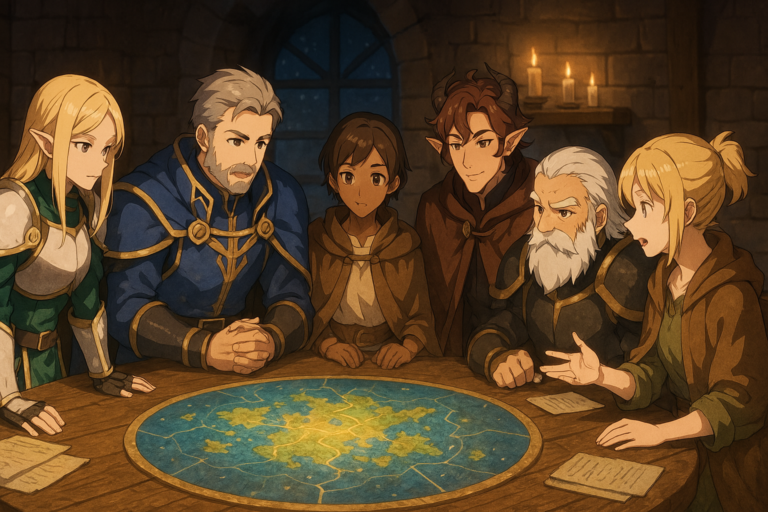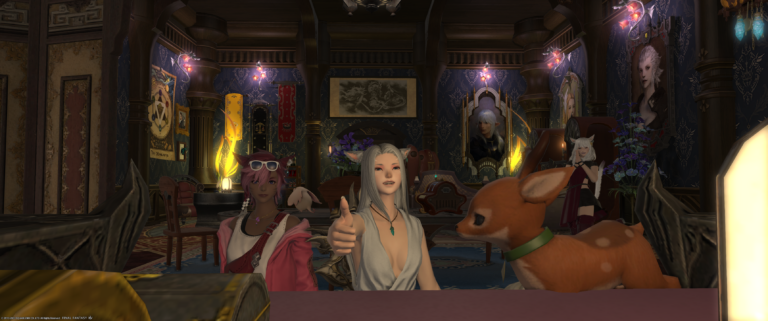Introduction
Guild ranks aren’t just cosmetic—they shape your community’s culture. Whether you’re running a cozy RP tavern, a hardcore raid team, or a social PvE guild, the way you structure promotions and titles can either inspire loyalty or create resentment. This guide explores how to build a meaningful guild ranking system that reflects your values, avoids power creep, and keeps your members motivated.
Why Guild Rank Structure Matters
A good guild rank system serves three purposes:
- Clarity – Who has authority? Who can help with what?
- Culture – What does your guild reward and recognize?
- Trust – Can members grow without threatening the guild’s integrity?
“Longtime members stuck at the lowest rank often feel forgotten, while unclear rank names confuse newcomers about who does what.”
Officer Roles vs. Guild Ranks: Why They’re Not the Same
Many guilds confuse roles and ranks, but they serve different functions:
- Roles are jobs or functions: recruiter, event host, mediator, tech admin.
- Ranks are social signals: how much trust, status, or recognition a member has.
You can have a “Veteran” who holds no active responsibilities, and a “Junior Officer” who’s doing crucial work.
Think of it like a company:
- Your rank is your title (Manager, Director, Intern)
- Your role is your job (HR, Finance, Customer Support)
When designing your system:
- Ranks = status + access + symbolism
- Roles = function + duty
Mixing the two without intention often leads to confusion: someone with a flashy rank but no responsibilities may look authoritative but lack function—and vice versa.
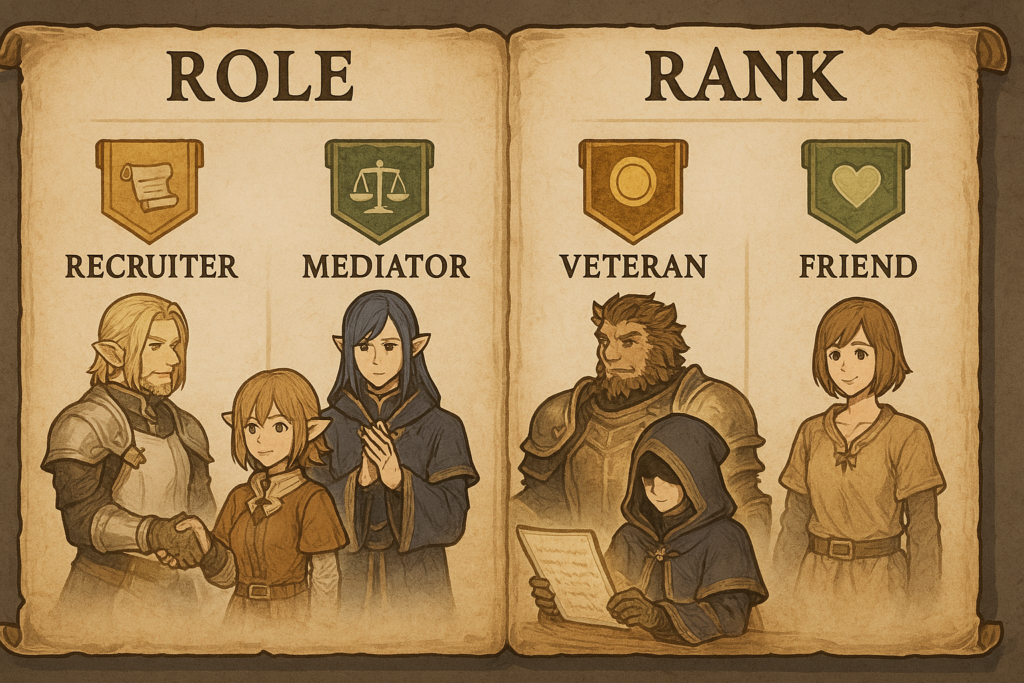
Practical, Symbolic, or Earned? Types of Rank Systems
The style of your ranks should reflect the kind of guild you’re trying to build:
1. Practical Ranks
- Clear, function-based: Leader, Officer, Recruit, Member
- Easily maps to in-game or Discord permissions
- Ideal for serious PvE/PvP guilds
Pros: Straightforward, minimizes confusion, supports accountability
Cons: Can feel sterile or uninspiring if not personalized
2. Symbolic or Meme-Based Ranks
- Guild-themed puns, lore references, or inside jokes
- Popular in RP or creative guilds
Pros: Builds culture, creates belonging, fun to earn
Cons: May alienate newcomers if jokes are too inside or opaque
Inclusive memes (like guild-themed titles) work well, but inside jokes that only veterans understand can make new players feel like outsiders.
3. Earned or Contribution-Based Ranks
- Reflects what members have done: donations, events hosted, time in guild
- Often used to identify trusted or legacy members
Pros: Screens for saboteurs, rewards long-term loyalty, builds trust
Cons: Can feel like a grind or favoritism if not transparent
One popular system assigns a placeholder rank (e.g., “Initiate”) until the member completes onboarding. Once verified, they’re promoted to full membership.
How to Decide Who Gets Promoted (and When)
Promotion should be tied to purpose—not just tradition or favoritism.
✅ Good Promotion Criteria:
- Time in guild (especially when combined with participation)
- Community contributions (events, advice, resources shared)
- Leadership traits (positivity, initiative, mentorship)
- Officer verification (if there’s an onboarding process)
⚠️ Risky Criteria:
- Pure popularity contests
- Drama-based voting systems (especially without moderation)
- Auto-promoting based on in-game level or wealth
Members voting for officers can work, but unmoderated votes often lead to toxic whisper campaigns or subtle sabotage.
Decorative ranks (with no permissions) can offer prestige without opening your guild to risk. Meanwhile, permission-based ranks should only be used when access is truly needed.
Avoiding Rank System Pitfalls
Here are common problems guilds run into when managing ranks:
❌ Unclear Ranks
“I can’t tell who’s a leader and who’s just roleplaying a fancy title.”
Make sure symbolic ranks still show some level of hierarchy or function.
❌ One Rank for Everyone
“I’ve been here for a year and still have the same title as someone who joined yesterday.”
Longtime members want to feel recognized—add seniority-based roles, legacy titles, or honorary badges.
❌ Rank Inflation (Power Creep)
“Now we have 14 officers and nobody knows who actually leads.”
Be mindful of over-promoting. Title inflation leads to confusion and undermines your actual leadership structure.
Decorative vs. Functional Ranks
Sometimes, you don’t want to assign technical permissions—but still want to reward members. That’s where decorative ranks shine:
- Symbolic titles like “Veteran,” “Storykeeper,” or “Raider”
- Used on Discord roles, forums, or in-character profiles
- Zero technical access—just a badge of trust
Meanwhile, functional ranks (like Recruiter, Banker, Event Host) should only be assigned if the person actively fills that role.
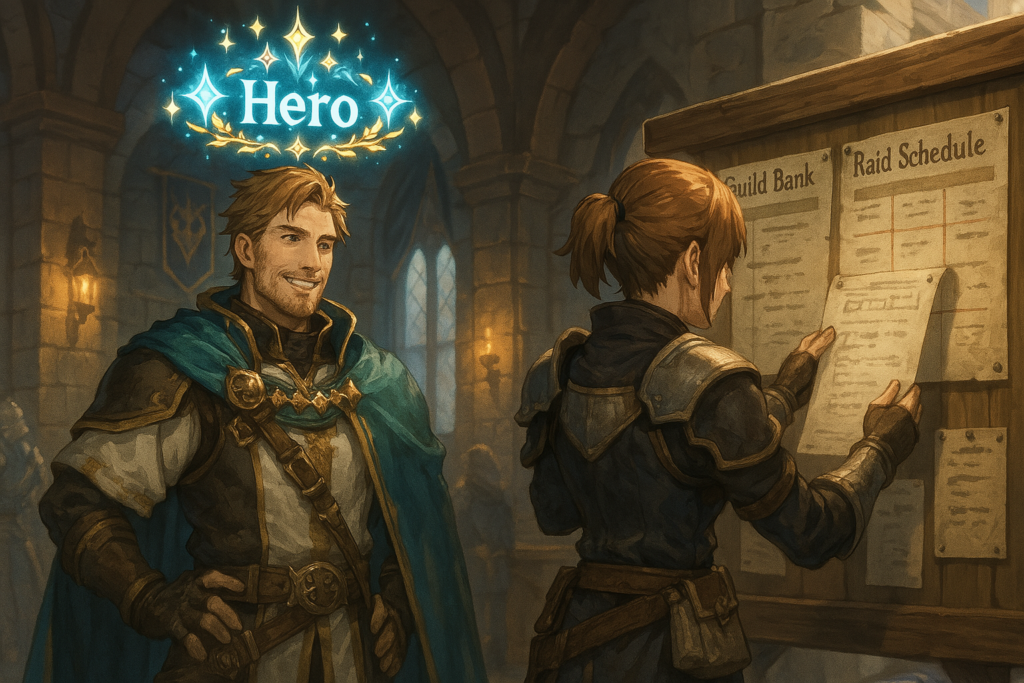
Promotions: Public or Private?
Promoting someone in public—through a Discord tag, event ceremony, or guild announcement—can be hugely motivating. But consistency matters.
Public Pros:
- Boosts morale
- Sets a cultural expectation
- Builds hype and camaraderie
Public Cons:
- Creates resentment if officers get lazy and don’t celebrate every promotion
- Sets a precedent you must maintain
“Public promotions are great until you forget to announce three in a row—and those players feel invisible.”
A good balance: use ceremonies for major rank ups or milestone contributions, and quick mentions for minor ones.
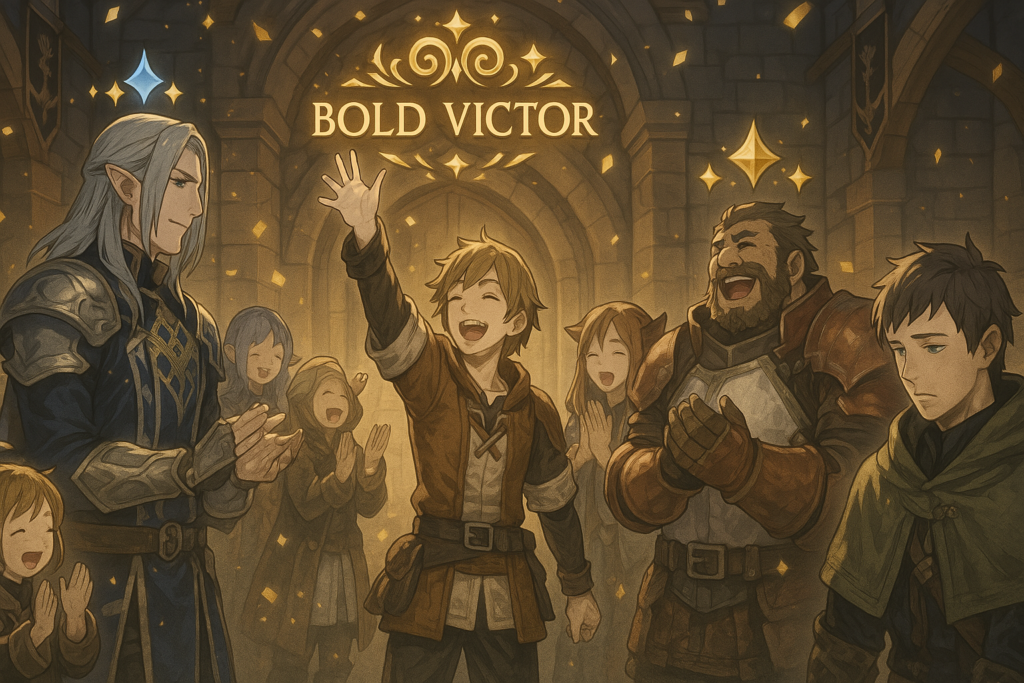
Creative Tips for Naming Guild Ranks
- Use military themes (Private, Sergeant, Commander) with fun twists
- Create guild lore titles (Flamebearer, Quartermaster, Lorewarden)
- Align with in-game mechanics (Gatherer, Raider, Scout, Strategist)
- Add decorative prefixes (Honored, Elder, Veteran) for legacy members
Mix fun with function: “Grunt” might be your standard member, but “Veteran Grunt” shows legacy. “Tavern Host” may be symbolic, but it tells members they run events.
🧠 Rank Naming Brainstorm Table Walkthrough
Use this table to brainstorm custom guild ranks based on purpose, naming theme, and implementation style. Each step builds on the last to guide you from concept to clarity.
📋 Step 1: Start With the Purpose
| Purpose/Function | Brainstorm Prompt |
| New or Unverified | What fits someone brand new but not yet trusted? |
| Core Members | What’s a welcoming but standard member title? |
| Prestige / Loyalty | How can you reward time and trust symbolically? |
| Support Staff | What would you call officers or behind-the-scenes helpers? |
| Specialty Role Leads | Who manages events, invites, or PvE squads? |
| RP / Culture Roles | What titles tie into your guild’s identity or lore? |
| Leadership Roles | What feels right for your top leader or council? |
📋 Step 2: Match the Naming Style
| Purpose | Theme Direction | Example Name Styles |
| Prestige / Legacy | Classic or Honored | Veteran, Elder, Founding Member |
| Role-based Function | Clear and Descriptive | Event Lead, Strategist, Recruiter |
| RP / Lore | World-building / Mythic | Flamekeeper, Watcher, Lorewarden |
| General Member | Welcoming / Casual | Citizen, Companion, Adventurer |
| Leadership | Formal / Noble | Guildmaster, Chancellor, Overseer |
You don’t have to pick just one theme. Combining clarity with creativity (e.g., “Lorewarden” instead of “Historian”) works best when introducing ranks to new members.
📋 Step 3: Determine Permissions or Symbolic Role
| Rank Name | Type | Symbolic Purpose or Job Function | Permissions (if any) |
| Newcomer | Functional | Awaiting onboarding | None |
| Member | Functional | Full access to social channels | Invite Members (Discord) |
| Veteran | Decorative | Loyalty recognition | None or legacy Discord flair |
| Strategist | Functional | Leads raid teams or PvP | Edit Calendar, Create Events, Invite Members |
| Lorekeeper | Symbolic | Guild story and culture steward | Moderate Channels, Edit Guild Lore/Docs |
| Guildmaster | Functional | Final decision-maker | All permissions |
Tip: Don’t assign access unless absolutely necessary. Symbolic ranks can still feel powerful without giving away control.
📥 Want the fillable version? Get the Google Docs companion worksheet here → (make a copy to use for your own guild)…Coming Soon…

Same vs. Different Rank Systems: Discord vs. In-Game
Many guilds operate across platforms (e.g., Discord + the game client). Should the ranks match in both places?
🎯 Same Ranks (Mirrored Titles)
Pros:
- Reduces confusion
- Reinforces identity and hierarchy
- Easier to recognize who does what across platforms
Cons:
- Limits flexibility—what works in-game might not fit Discord’s structure
- May force compromises due to platform constraints
🎭 Different Ranks
Pros:
- Lets you tailor Discord for community roles (like Artist, Memer, Veteran) and in-game ranks for utility (like Invite Permissions, Banker)
- Helps separate social recognition from access
Cons:
- Can confuse new members if not documented clearly
📌 Recommendation: Mirror essential ranks (Leader, Officer, Recruit), but use Discord’s flexibility to add fun or social layers without compromising in-game hierarchy.
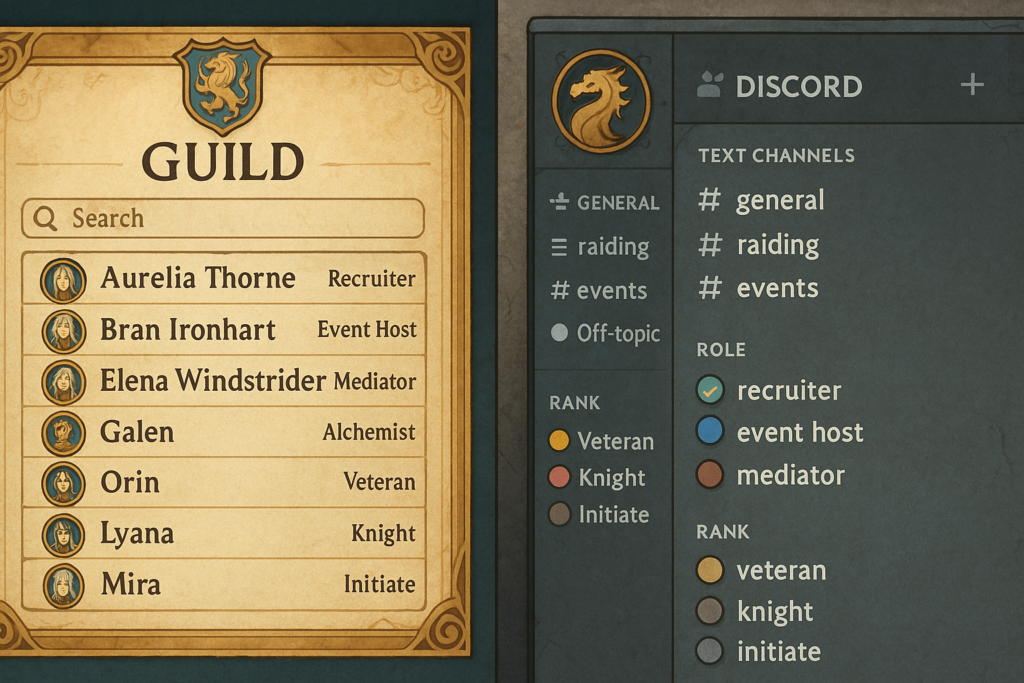
Mixed-Purpose Guilds (RP + PvE/PvP) and In-Game Limits
MMORPGs often limit the number of ranks you can assign. For guilds that combine RP with PvE/PvP, this creates tension:
- RP might want lore titles like “Captain” or “Storykeeper”
- PvE needs clarity: “Tank Lead,” “Raid Officer,” etc.
💡 Solutions:
- Use in-game ranks for functional clarity
- Use Discord or forums for RP hierarchy, lore, or honorary titles
Example: In-game, your title is “Raider.” On Discord, you’re “Knight of the Burning Order.” It keeps the game clean and the roleplay immersive.
Also consider layered tagging in Discord, allowing members to carry multiple identities (e.g., PvE Veteran + RP Lorekeeper).
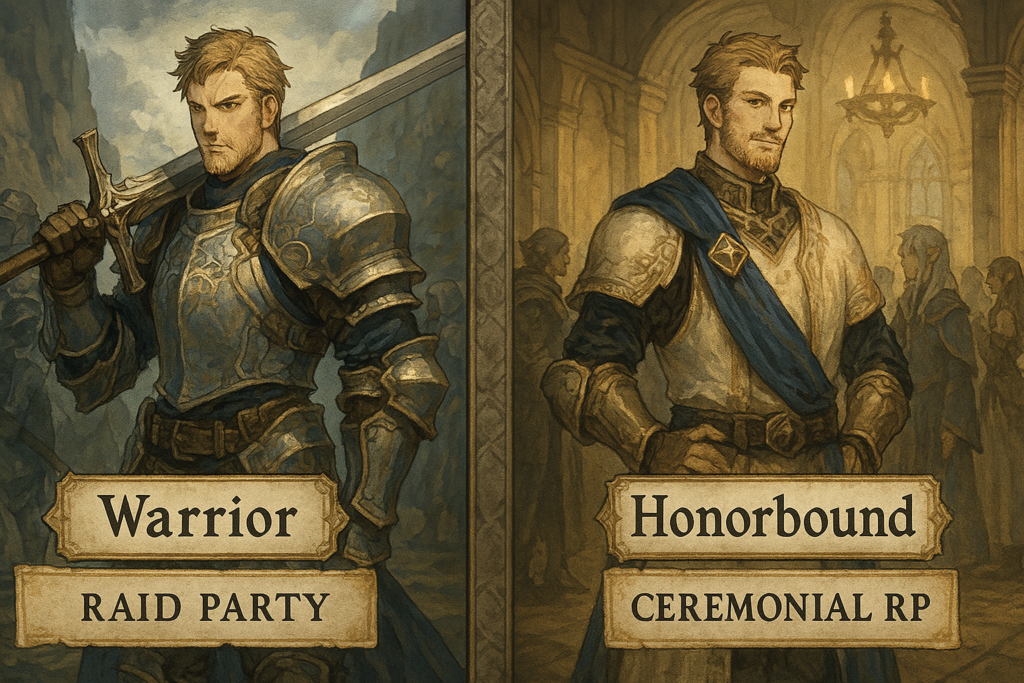
Leadership Title Perception: What Research Says
Leadership psychology and organizational research suggest that titles shape perception, not just access.
- A leader’s title sets expectations: “Guildmaster” feels more authoritative than “Facilitator.”
- People assign legitimacy and accountability based on the title’s tone and positioning.
- Overly casual titles can reduce respect, while overly grand ones like “Dictator” can create distance or seem egotistical.
📊 Key Dynamics:
- High-status titles (Guildmaster, Commander) reinforce hierarchy but must be backed by presence and visibility.
- Low-status leaders (e.g., using “Helper” or no title) risk being bypassed—even if they have real power.
HR studies show that title inflation can cause confusion, but title ambiguity causes disengagement.
📌 Tip: Choose a leadership title that reflects the tone of your guild and sets a clear expectation of responsibility and leadership presence.
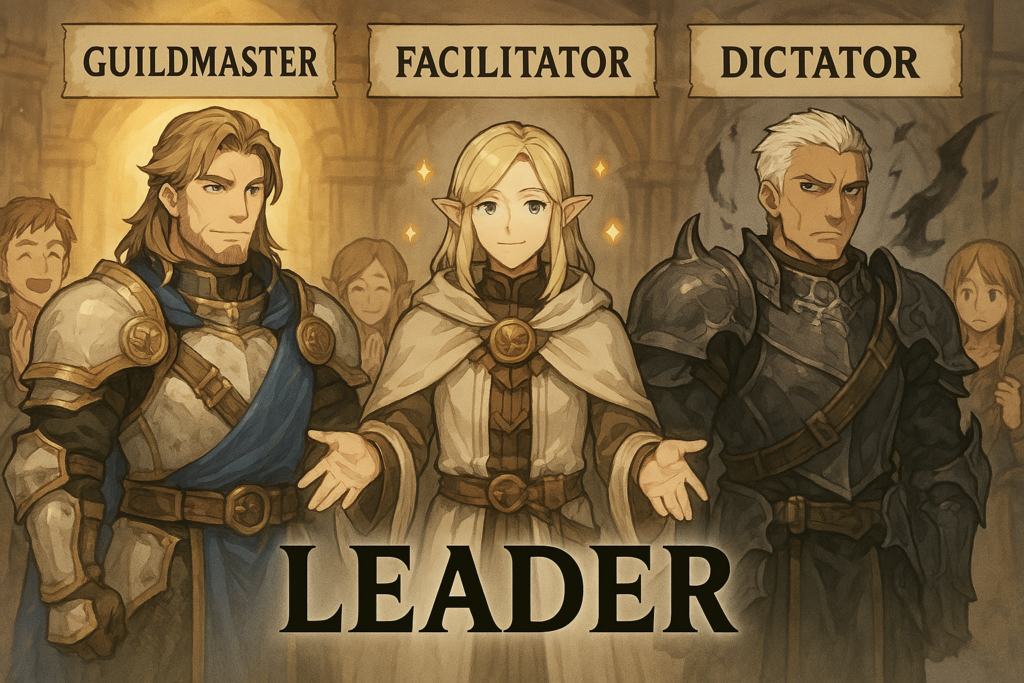
Shared Leadership Titles: Co-Leads and Council Perception
Guilds often opt for co-leaders or councils to avoid authoritarian structures—but leadership psychology suggests some trade-offs.
✅ Pros of Shared Leadership:
- Encourages collaboration
- Reduces burnout or power hoarding
- Creates flexibility during absences
⚠️ Cons:
- Can confuse members on who the final decision-maker is
- Diffuses accountability: “If everyone’s in charge, no one is.”
Studies from business and non-profit orgs show shared leadership works best when each leader has a clear domain of focus.
🧭 How to Do It Well:
- Give each co-leader a defined area (e.g., PvE lead, RP lead, Recruitment lead)
- Still assign a primary title or visible “point person” to represent the guild externally
- Make the system transparent: use org charts, Discord pinned messages, or role descriptions
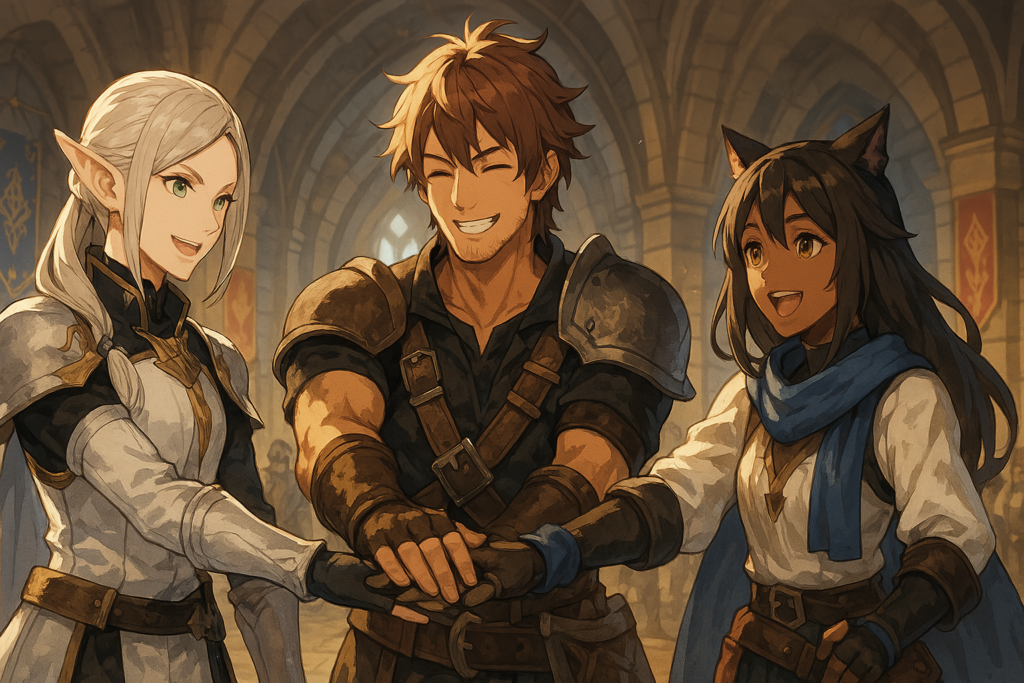
Romantic Couples Co-Leading Guilds: Dynamics and Considerations
When romantic partners co-lead a guild, unique dynamics emerge that can influence the guild’s environment and operations.
✅ Pros:
- Unified Vision: Couples may have a strong, shared understanding of goals and values, leading to cohesive decision-making.
- Enhanced Communication: Established personal communication patterns can facilitate efficient discussions and resolutions.
⚠️ Cons:
- Perceived Favoritism: Members might believe that decisions are influenced by personal relationships rather than merit.
- Conflict Spillover: Personal disagreements can bleed into guild management, affecting objectivity and professionalism.
Research indicates that workplace romances can lead to perceptions of favoritism and potential conflicts of interest, impacting team dynamics.
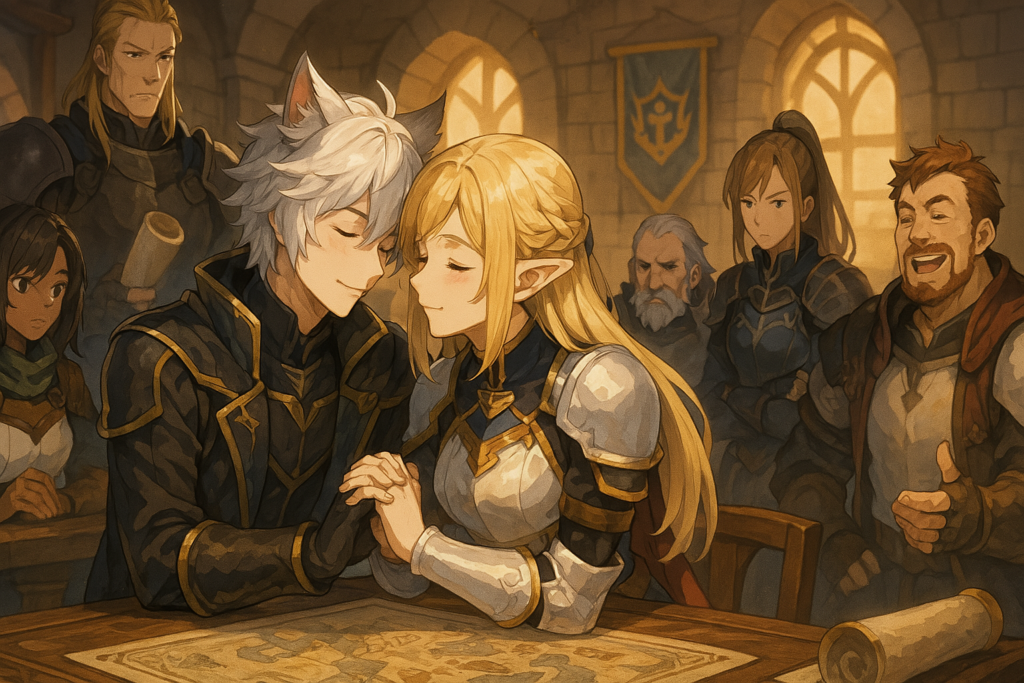
Anecdotes: When Promotions Go Awry
😬 Horror Story: The Mistrusted Officer
On Reddit, a guild leader shared how they promoted a charismatic but manipulative member who seemed popular. Within two weeks, the new officer had changed Discord roles, kicked members who challenged them, and looted the guild bank. The fallout led to a mass exodus and the guild disbanded.
❤️ Feel-Good: The Legacy Couple
On MassivelyOP, a longtime couple described how they built a community-first RP guild over eight years. They ran events, handled recruitment, and maintained a rotating leadership council to prevent perceived bias. Members praised the emotional warmth, fairness, and depth of their leadership.
Whether promoting someone new or co-leading with a partner, transparency and structure matter more than personal charm or chemistry.
Final Thoughts
Your guild’s ranking system is more than just flair—it’s a framework that communicates your values. Whether you go functional, symbolic, or a mix of both, the key is consistency, clarity, and a little creativity.
Recognize long-term members. Protect access with trust. Use titles to make people feel like they belong—not like they’re stuck.
📢 Do you use symbolic or earned ranks in your guild? Show us your best ideas and join the discussion on Discord: https://guildtheoryonline.com/discord

